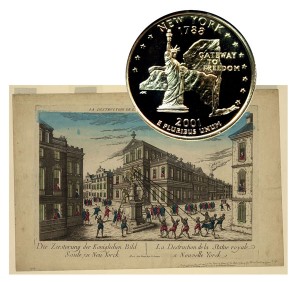Today, the New York State Quarter Coin remembers the political difficulties 241 years ago with some supporting the king and others desirous of liberty.
The Diary of the Revolution include two entries for March 2, 1775.
One talks of building a new port upriver with expectations the American forces would shut the New York port. The second tells of how New York’s powerful men support the king while its people do not.
=====
March 2. — It is said that some people in Dutchess county, New York, and others on the opposite side of Hudson river, are engaged in a scheme for establishing a port in that part of the country.
They have a place in contemplation, where they say a few hundred pounds, properly bestowed, in building docks and quays, will accommodate fifty top-sail vessels.
This plan, it seems, was projected some years ago, but was neither prosecuted nor made public.
A suspicion, that the misconduct of the city merchants, under the influence of the Congress, may soon cause the only port of the province to be shut up, has now revived it.
Should we bring upon ourselves this punishment, it is imagined there will be no difficulty in obtaining the privilege of a custom house for the river; the consequence of which will be, that all the country beyond it will be much benefited, and all the estates within twenty miles of it will be vastly increased in their value, and New York will finally and irrecoverably lose one-half of its commerce.
A large majority of the inhabitants of the upper counties are well affected to government, and it is thought that the above-mentioned scheme will soon make proselytes of all the rest.
—–
March 2. — New York, after being one of the most refractory cities on the continent, is become the most submissive and obedient, for the people have not only built excellent barracks for the army, but also supply the troops with every necessary of life.
Lately the Assembly voted money for the current year, and, notwithstanding the passing the Stamp Act, and duties on paper, glass, painters’ colors, and on tea, and their assembly annihilated by tyranny, yet that very assembly, when afterwards suffered to meet, immediately granted fifteen hundred pounds to be invested in an equestrian statue of his Majesty, on the arrival of which it was erected on a square near the fort.
Yesterday being the anniversary day of its erection, Governor Colden, with his wretched council and assembly, the mayor, and aldermen, with the military, went in procession to the spot, where, after surrounding the leaden horse and his rider, the common crier made proclamation for the whole company to be uncovered, when an oration was made by the town clerk, in which he recited the many blessings they enjoy under this pious reign, after which they drank his Majesty’s health, and returned to their respective homes amidst the hisses of the people.
The wretches above mentioned met in council and assembly, have by a majority voted not to obey the General Congress resolution, but to protest against and oppose all the continent of America, who are making so noble a stand in defense of their liberty, while the people wish to do the same.
But they are unhappily in the hands of dependent placemen, contractors, informers, a refugee Roman Catholic family, and others, the veriest reptiles on earth.
New York, therefore, is the only colony on which the British junto must rely to enslave America.
=====
As for the statue, in the Battles of America by Robert Tomes:
=====
The crowd, after hearing the document read [Declaration of Independence on July 9, 1776] on the common, rushed tumultuously to the “Bowling-Green,” and pulled down the equestrian statue of King George III, which stood there.
The royal effigy was of lead, but had a coating of gilt. When it was tom down, it was broken into pieces; and a faithful annalist records that most of them were sent to Weathersfield, in Connecticut, where Governor Wolcott’s family of two daughters and a son patriotically melted them into “forty two thousand bullets.”
=====
The New York State Quarter Coin shows beside an artist’s depiction, circa 1770s, of the removal of the King George III statue.
